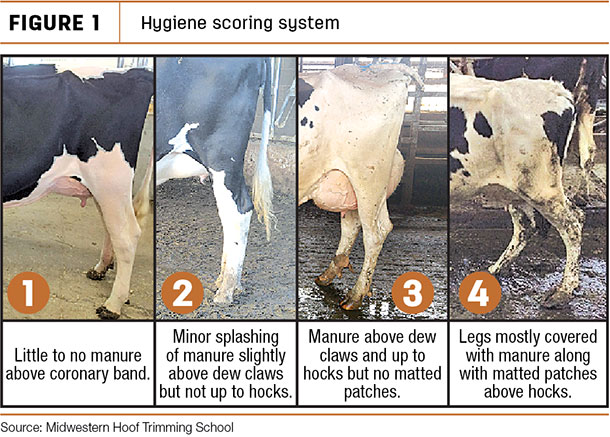What is the best product to run in my footbath? How often should I run my footbath? These are questions I am often asked by dairy producers. It seems everyone is looking for that “silver bullet” to control digital dermatitis (DD).
While there are many great products out there, and DD is very easily controllable, the real solution is understanding DD and preventing the outbreak and future spread with strict protocol.
While there are many factors that can contribute to the control or spread of DD, the single largest factor I see playing a role in the control of DD is hygiene. In fact, I would say cleanliness of both cows and facilities is the true “silver bullet” for DD.
Hygiene
There are many ways to assess hygiene, but it’s really pretty simple. Ask yourself these questions:
Do your floors get cleaned frequently?
Let’s look at cleaning frequency for two common manure removal methods: manual scraping (skid steer) and mechanical scraping (alley scrapers):
- The best option is manually scraping the floors three times per day while the cows are in the parlor/holding pen. This way the manure never gets pushed up onto the cows’ legs.
- The next best option is having alley scrapers running continuously. This keeps the floors pretty clean while never pushing much of a load of manure past the cows while they are standing.
- A less favorable option is manually scraping twice each day while the cows are in the parlor/holding pen. This does not push manure up onto the legs because the cows are not present at time of scraping; however, the manure in the alley does build up significantly more on twice-a-day scraping and allows the feet to become covered with manure and stay wetter.
- The least favorable option is alley scrapers running intermittently because this allows a build-up of manure and pushes a large puddle over the cows’ feet while they are standing and walking in the alley. The constantly wet environment is ideal for DD.
Are your cows’ lower legs covered in manure?
- If your cows’ lower legs are covered with manure, then you are going to have a harder time battling DD.
Is the cows’ overall habitat generally wet or dry?
- Not only does a wet habitat provide bacteria a comfortable atmosphere, but it also produces a macerated dermal layer that allows bacteria to penetrate it and cause the infection.
While hygiene is not the only contributing factor in controlling this disease, it will have the biggest impact on how aggressive you will have to be to control DD with your footbath. It also impacts the treatment’s ability to penetrate through dried-on manure on the feet.
When it comes to footbath solutions, there is no single answer for what to use or how often to use it, as every farm will have different environmental conditions and stress levels. Some cows will be more likely than others to fall victim to the disease.
I have worked with farms who have excellent hygiene and less than 1 percent incidence of DD by only running footbaths three times per week, while other farms that run footbaths seven days a week are seeing more than a quarter of their herd affected by the disease.
The main contributing difference between the two is the hygiene level from one farm to the other. This can be easily identified by a hygiene scoring system of the cows. A 4-point scoring system can be used to do this (Figure 1).
Footbath strategy
The second-largest factor I see in controlling DD is footbath strategy. Before we worry about which product works best, it’s good to understand that the product being used is only as good as the footbath it is in.
If you are just dumping product in without doing some research and planning, you are likely wasting time and money and losing future profits. Ask yourself these questions to evaluate your current strategy:
Is the footbath laid out properly, and is it in a good location?
- To gain maximum effectiveness in your footbath, it must be the right size and located in a usable location. A footbath that is long and narrow will allow for more steps per foot with the same amount of product, maximizing your cost per cow.
Another thing to consider is: A footbath that is not in a convenient location for both the cows and producers will very likely not be used and therefore is no footbath at all.
Is there a protocol in place for running the footbath, including proper pH testing and mixture calculation?
- A footbath that is not calculated out properly for the correct mixture will likely be ineffective – and therefore not be used or used improperly and money lost and wasted.
Is the footbath being changed at proper intervals?
- Footbaths should be changed roughly every 200 cows. As water is tracked out and manure is tracked in, it will eventually contain more bacteria than treatment, at which point it will become a liability, not an asset.
If your footbath is not a well-managed tool, then it won’t matter which product you are using on it. The real “silver bullet” is keeping the floors as clean as possible with good hygiene, complemented by a well-designed footbath.
These simple tweaks to your routine or design to maximize cow health and comfort by controlling DD will have a rewarding payback. ![]()
Aaron Lavoy is with Midwestern Hoof Care. Email him Aaron Lavoy.






